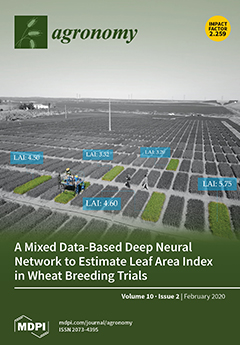The depth distribution of soil organic carbon (SOC) in a soil profile is important to examine the effects of different treatments on SOC sequestration. This study was conducted to determine the effects of different vegetation types on the concentration, storage, and stratification ratio (SR) of SOC in northeastern China. Five vegetation types,
Leymus chinensis (LEY),
Puccinellia tenuiflora (PUC),
Echinochloa phyllopogon (ECH), saline seepweed (SUA), and
Chloris virgata Swartz (CHL), were selected as treatments. Soil bulk density and SOC concentration were measured at 0 to 50 cm depth, and SOC storage and four SRs (SR1 [0–10:10–20 cm], SR2 [0–10:20–30 cm], SR3 [0–10:30–40 cm], and SR4 [0–10:40–50 cm]) were calculated under the five vegetation types. Results showed a pronounced reduction in SOC concentration with increasing soil depth. Vegetation types had significant effects on SOC concentration and storage. Under PUC, ECH, SUA, and CHL treatments, SOC concentrations (2.150, 1.068, 4.110, and 2.542 g kg
−1, respectively) and storages (15.075, 7.273, 30.024, and 18.078 Mg ha
−1, respectively) at 0–50 cm depth were lower than those under the LEY treatment. SR1 values were all < 2, while SR2, SR3, and SR4 values were all > 2 except for SR2 under ECH and SUA treatments. Vegetation types had significant effects on SR3 (
p < 0.001) and SR4 (
p = 0.040), while no significant differences were found for SR1 and SR2 due to the narrow range, with values of 0.248 and 0.553 for SR1 and SR2, respectively, among the vegetation types. These results indicated that the degraded soils have great potential to sequester organic carbon in northeastern China, and SR3 could be used as an effective index to show the changes in SOC concentration and soil quality in northeastern China.
Full article





